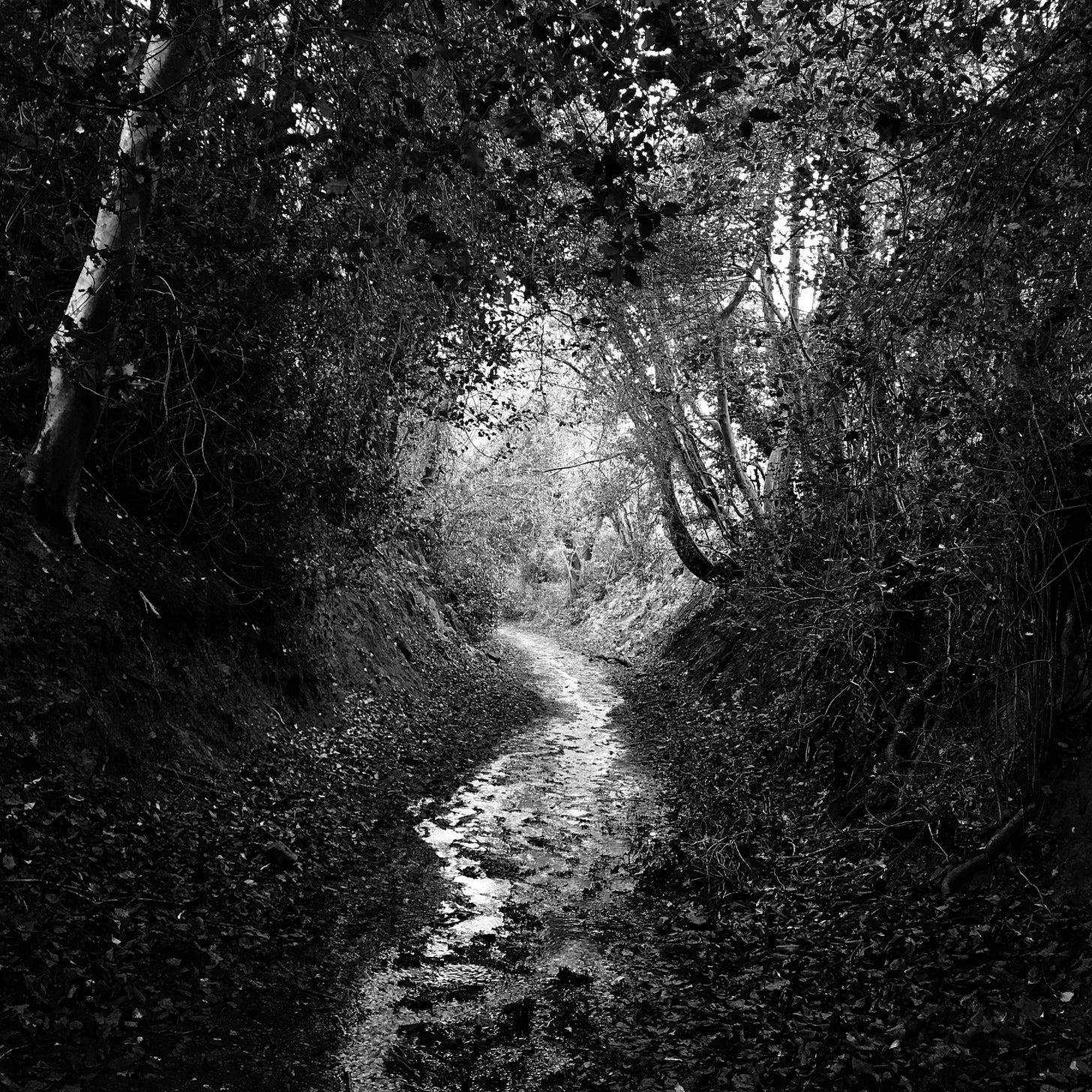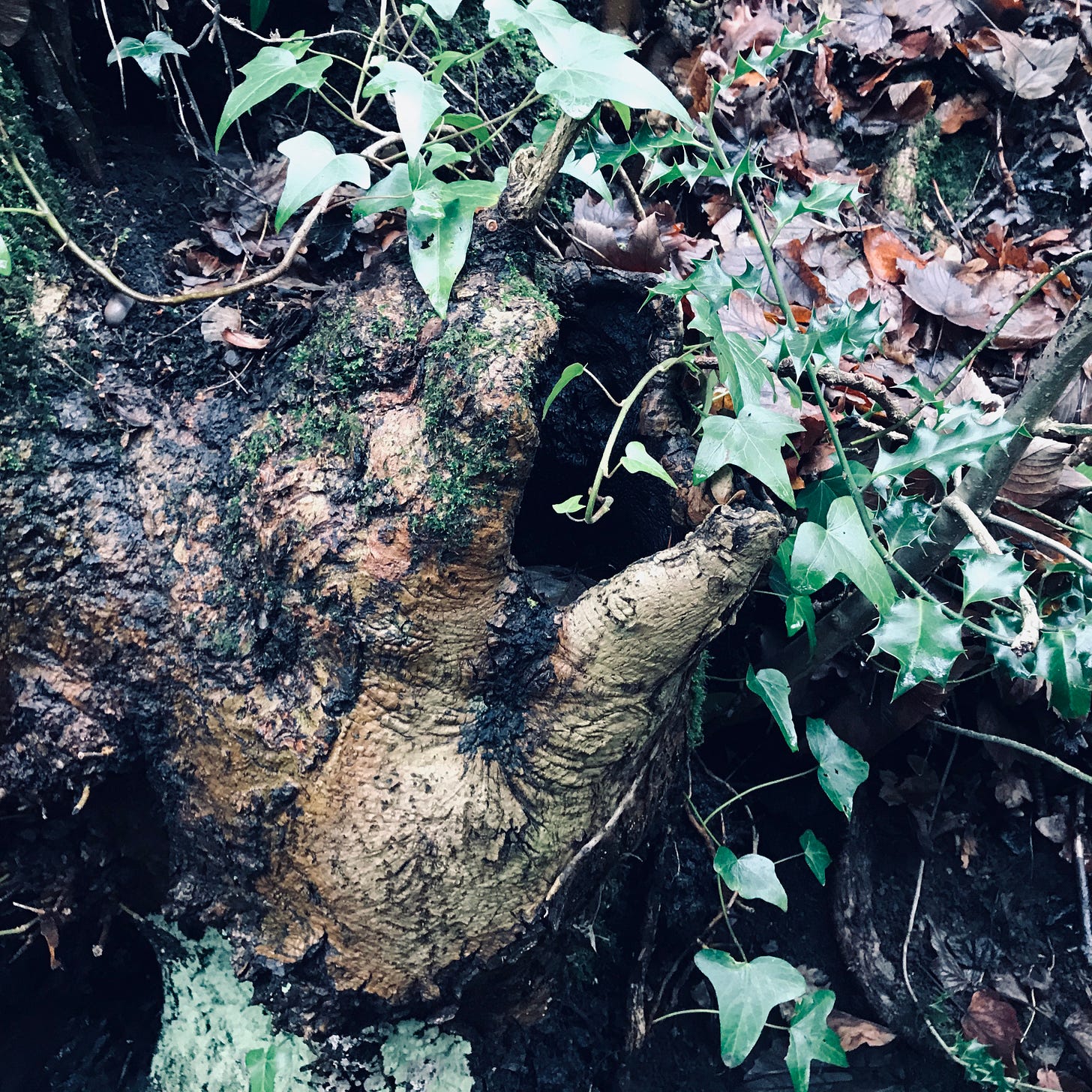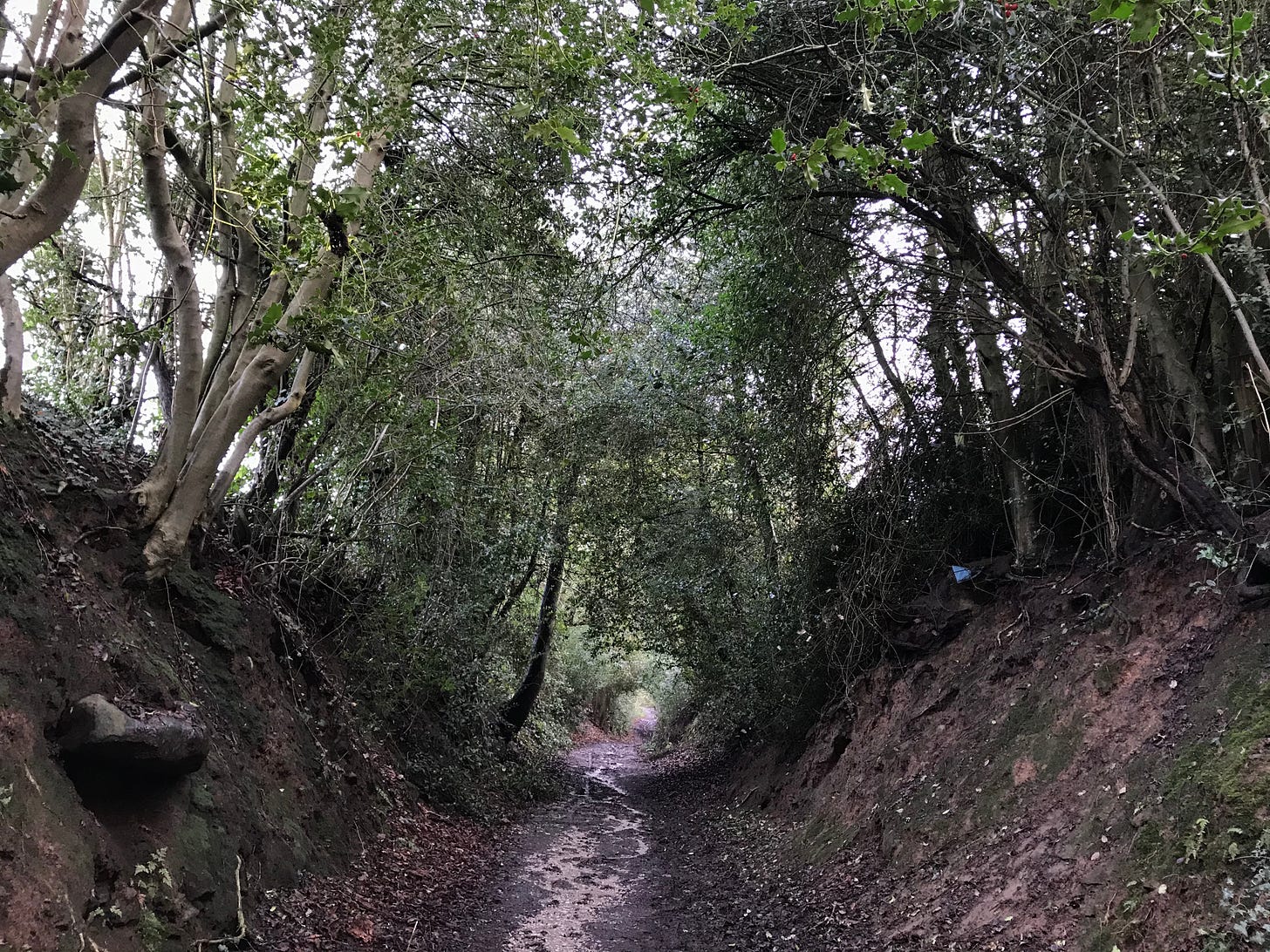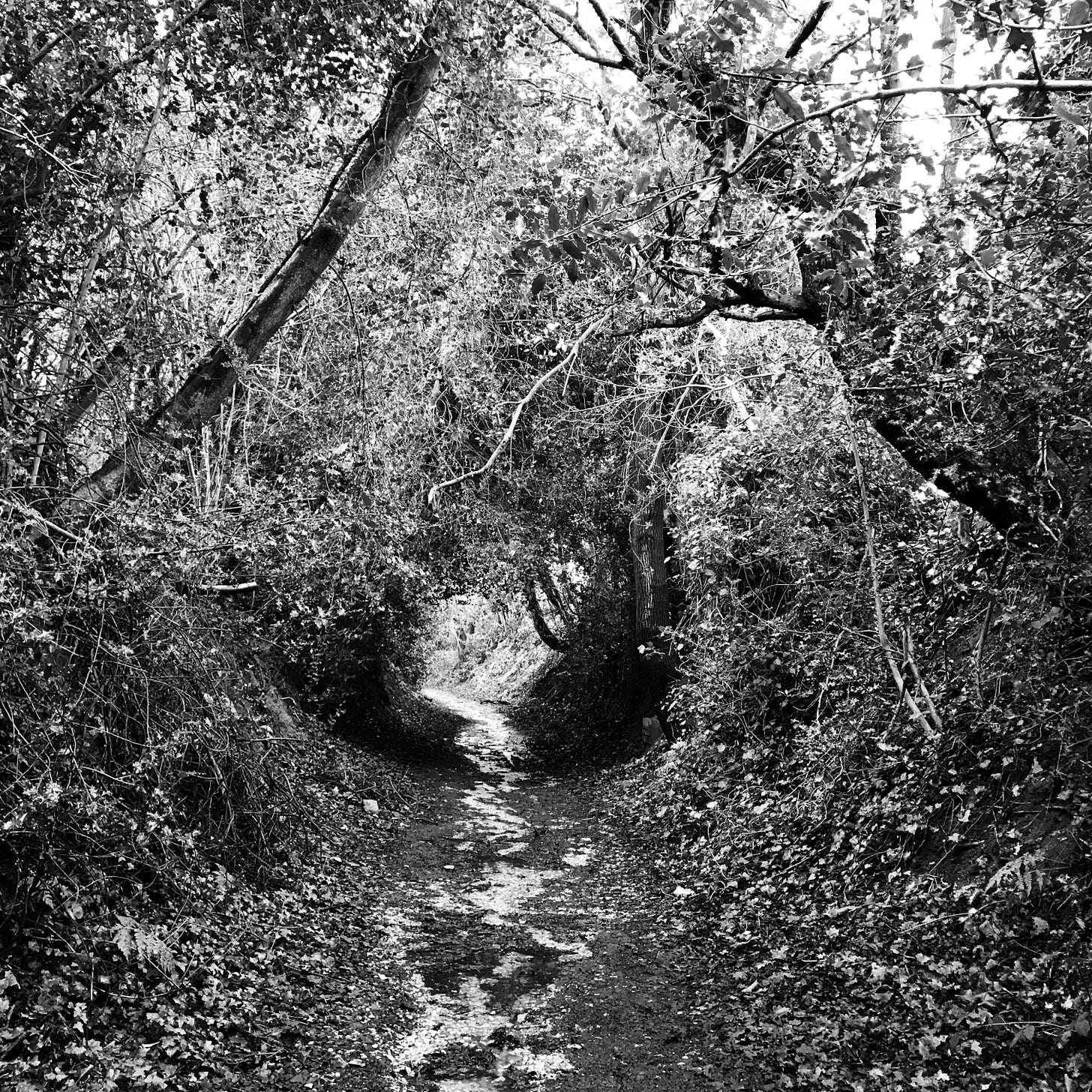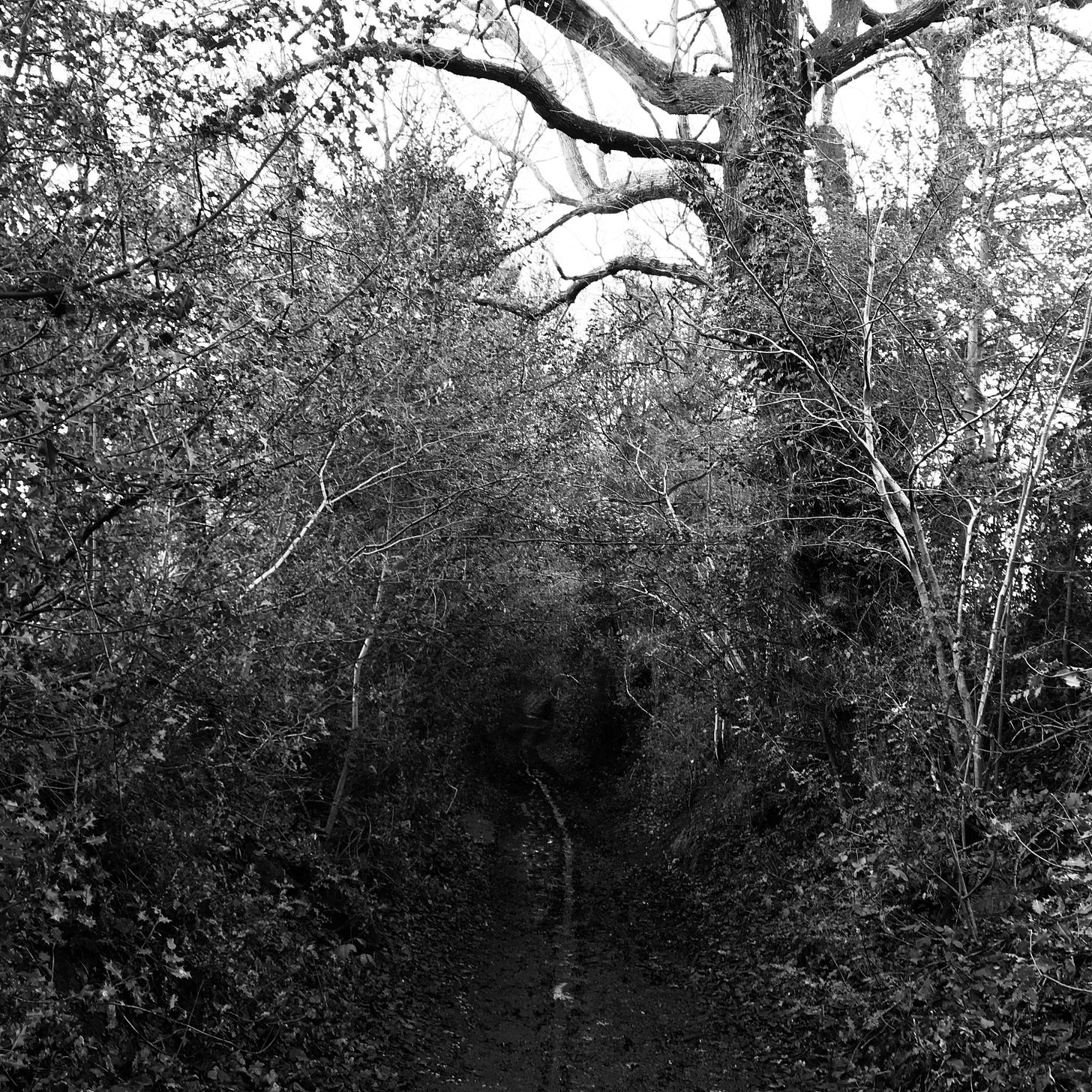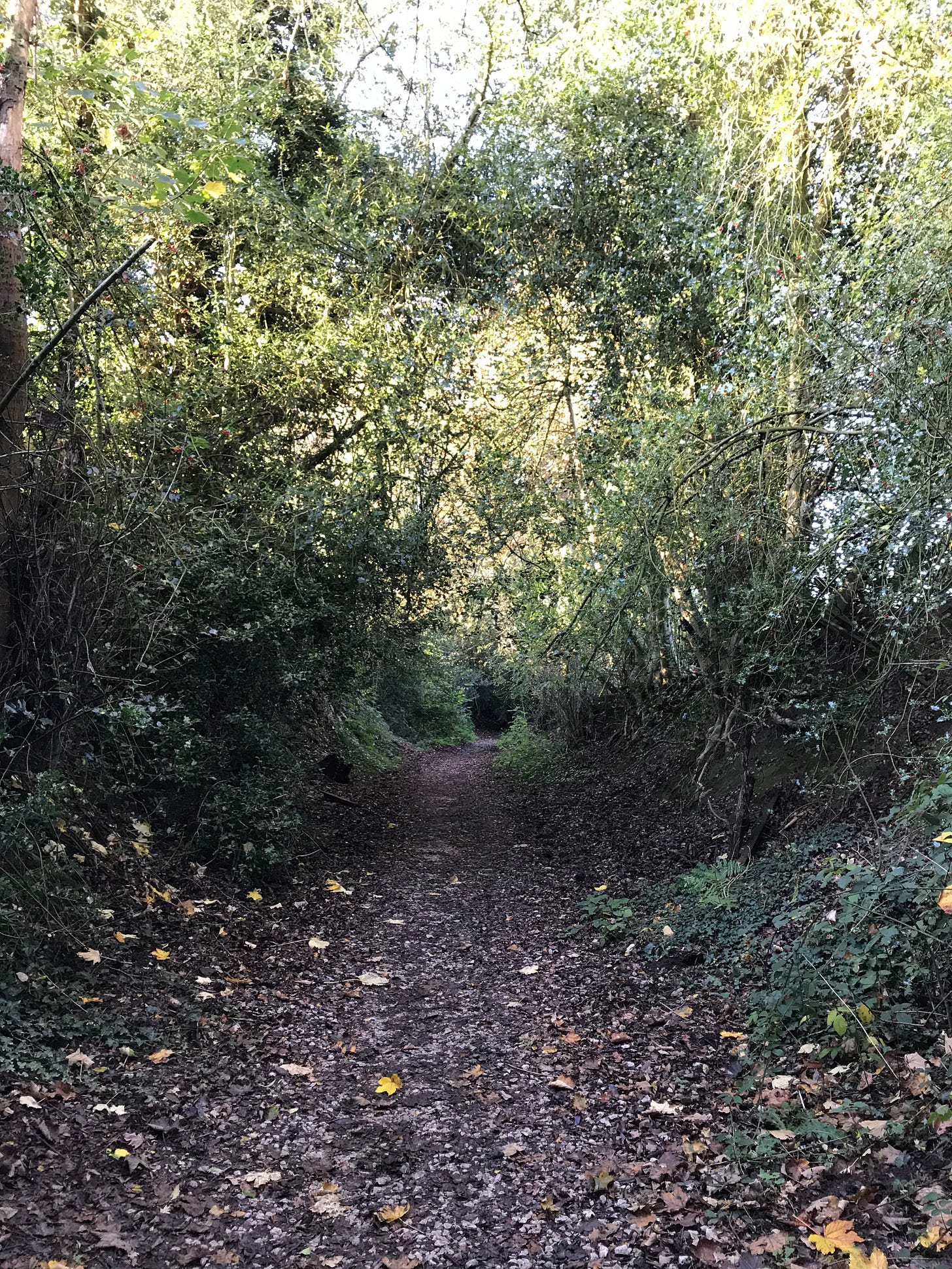The Holloway of Dark Lane
Dark Lane - its subterranean aspect allows eye-level encounters with roots of holly, oak and beech, strata of earth and rock; it is certain to turn your horizon into a green tunnel the aperture of which you never quite reach; it is unadvisable to look over your shoulder in the dark.
Dark Lane is a path I have known all of my life. Deeply sunken, its walls are made of rock and root and earth, ten to twelve feet above the ground. Beech, birch and the odd oak grow, visibly clinging on to the steep sides, their roots bared.
Holly and ivy hang into the path in evergreen pennants. More so than in winter when the trees are spare, Dark Lane earns its name in summer when the trees that form its roof meet in the middle, their leaves conspiring a green midday dusk. A stream, unnamed on the map, flows down and across the sunken lane close to its head and disappears into the ground before it reaches the holloway’s foot. Holloways have a history of hiding the hunted and Dark Lane is no exception: there are badgers excavations and fox spoor, the pungent smell lingering long after its maker has left. The bedrock under-foot—and above-head—here is gritstone, a rock soft enough to be hollowed on pathways of considerable antiquity.
I remember the thrill I felt when I first read Robert MacFarlane, Stanley Donwood and Dan Richard’s Holloway and perceived for the first time that this mysterious, enchanting word described what Dark Lane is. This is how the book begins:
Hol weg.
Holwy.
Holway.
Holeway.
Holewaye.
Hollowy.
Holloway.
Holloway - the hollow way. A sunken path, a deep and shady lane. A path that centuries of foot-fall, hoof-hit, wheel-roll & rain-run have harrowed into the land. A track worn down by the traffic of ages & the fretting of water and in places reduced sixteen or eighteen feet beneath the level of the fields.
Hollways don’t exist on the unyielding rock regions of there archipelago…but where the stone is soft - malmstone, greensand, sandstone, chalk…1
This is how holloways are made then. Foot, hoof, wheel, rain and, importantly, time. The book describes ways in which holloways might make us, the bearing they have on our minds as we walk through them.
Many of those who have walked these old ways have seen them as places where one might slip back out of this world, or within which ghosts softly flock… One need not be mystic to accept that certain paths are linear only in a simple sense… They are rifts within which time might exist as pure surface, prone to recapitulation and rhyme, weird morphologies, uncanny doublings.2
Holloways, perhaps more than other old tracks, invite thoughts of the past, of ghosts, of the mysterious other-wheres that lie quietly in the soft bedrock of our minds and which are often sculpted by place. A deep holloway will encase, cradle a walker, the steep walls not easily scaleable, exit only possible where the lane levels out. Up ahead the only horizon you can see is a circular throat, a vortex that will surely swallow you, though it cannot be reached. Stepping into the concave lane, there is a sense of walking abruptly into an other-world not quite of the world you just left and will soon emerge back into.
It has been a dispiriting few weeks of unrelenting rain and gloom, the lanes and ways clogged with black ooze. I stepped out to walk to Dark Lane one morning at about nine o’clock. As a stiff wind blew into my face, for the first time this year the sun broke through the clouds and instantly lifted the spell of oppression and lethargy the days of overcast skies had been casting on me. Soon, I stepped onto, into, Dark Lane and a central channel gleamed white. The rain-soaked weeks had formed a thin skin of mud over the white gravel that gets deposited on the lane to prevent erosion and mudslides, and a fast-flowing stream of running water had cut through it, revealing the white beneath.
rain-run
A strange guttural cry alerted me to the pass-over of three ravens that flew over the small portion of sky I could glimpse from the sunken track. Each raven made a very different noise to the other, all three impossible to describe. More ravens, perhaps the same ones, patrolled the fields beside the lane when I left it some time later. More than once I spotted the blue and white flash of a retreating jay.
Dark Lane is close to a very noisy section of the Derwent Valley. On the A6 road between Milford and Belper there are number of industrial sites, residential areas, more recently the building sites of two large housing estates, and the ever-present companion of the southern Derwent Valley: the A6. Dark Lane is normally brimful of this noise pollution; the timeless, liminal space that is cradled in this old way is hauled constantly back into the busy 21st Century. Today, the brook in winter-spate and the wind surging through the trees outdid these noises, enhancing the twilight-world of the lane with a purely elemental soundscape. The wind dropped at times, leaking motorbikes and pneumatic drills into the holloway, and so I flitted between worlds, the primitive and the industrialised.
I followed the water up the lane, walking in the mud to the sides of the stream-path.
foot-fall
About half way up I smelt the pungent fruitiness of a fox, which perhaps I’d just missed catching sight of, as I could hear something large moving around out of sight over the lip of the holloway. The pooch ran up the steep side to investigate, at exactly the same spot she investigatively scaled the walls the last time we were here, which reveals something of the fox’s habits. One summer on an early walk, I disturbed a huge sandy dog fox in the fields above Grange Farm on the way to Dark Lane. It half-jumped to peer at me over a gap stone stile, and was gone. The fields hereabout are mapped with smeuses, visible tracks of the night roves of badgers and foxes. They create their own holloways, tunnels through the grass, bushes and briars that allow us some inkling of their nocturnal wanderings. Above their holloways through the vegetation, in the places where barbed wire is strung across their desire lines, there are snags of red fur and black and white fur growing steadily fatter.
There are several sunken lanes in the Old Frith, but Dark Lane is the deepest, possibly because it was part of the old Derby to Chesterfield coaching road and for some time experienced heavy traffic.
wheel-roll, hoof-hit
Before Jedidiah Strutt built his cotton mills at Milford and changed this valley forever, there was no bridge over the Derwent between Duffield and Makeney, and no road through the valley to the west of the river, where the A6 now runs. Makeney, on the east bank of the Derwent, was then the more important settlement, and so the roads on the east side were more heavily used than they were latterly, when Milford became the site of the Strutt cotton mills and expanded into a bigger settlement than Makeney. An article in the Belper News from 1936 laments the loss of the coaching road that Dark Lane was part of, reporting that its ‘gradual disappearance’ means that it ‘is now reduced to a narrow ditch, a trickling stream between two ever approaching banks overgrown with grass and bush.’3 Ever approaching banks.
This suggests that, in living memory, the holloway has changed form, closing in on itself, growing wilder as it sheds its fading past as a road important to human machinations.
In front of the Holly Bush Inn at the end of Dark Lane, a guide stone that was once located on the lane itself is a lasting testament to the coach road, even as the lane itself is forgetting. According to the Derby Daily Telegraph, the guide stone was taken from Dark Lane and planted outside the inn in 1891 by a previous tenant holder of the pub, the brilliantly and Hardy-esque named Octavius Parkin.4 It reads:
Derby
Coach
Road
1779
The Derbyshire Historic Environment Record website has a collection of photographs of the stone and between 1979 and 1988 the visible part of it has shortened as the road level has risen. The lanes will have their vagaries: Dark Lane is closing ranks, Holly Bush Lane is rising.
Tales are birthed in Dark Lane’s incurvate eaves and half-moon loam, legends stirring in its thick shadows. Hidden, subterranean, overgrown, encompassing, holloways carve out spaces for mystery in the topography of our imaginations, are reliquaries for fancies, imaginings and half-truths where people can keep their dreams of the past. Dark Lane, along with the the Holly Bush Inn, has long been associated with highwaymen Dick Turpin in the mind of local folk. According to legend, he supped in the pub after riding his horse down the holloway. He is mentioned on the pub's Twitter bio, on their website’s homepage and a picture of him by local artist Barney Bodoano hangs in one of their outdoor rooms. Highwaymen in general, and Turpin in particular, are heavily romanticised. Turpin was in fact a dangerous and violent man, not one you would want to meet on a dark lane, nor one you’d wish on the bygone folk of Makeney, however twinkling his rapier hilt might have been.
His legacy in folklore has been heavily influenced by Victorian novelist William Harrison Ainsworth, who invented Black Bess and Turpin’s famous but fictional ride from London to York in one night in his novel Rookwood. Makeney’s Turpin myth, which is certainly not true, is surviving happily, the lane’s history as a coaching road forming a solid weft for an imaginative warp. Myth is not the only form of romanticism Dark Lane induces. The writer of the Belper News article mentioned above imaginatively brings its past to life:
‘As we gaze silently at this insignificant ditch and conjure up the image of the old coaches rumbling up and down its course and imagine we can hear the tootling of the horn, we can only exclaim ‘Ichabod, Ichabod!’ [faded glory]
What the writer has failed to see is that their romanticism shows they are being worked on by the subtle, reality-warping ways of the ‘insignificant ditch’. Neither am I immune, and one early winter morning when an unseen horse whinnied loudly from somewhere above Dark Lane’s bank, I whipped round, looking for Dick.
On my windy walk, my canine companion flowed between the outer and inner world of Dark Lane, fearlessly scaling then descending the banks, through strata of soil, root, rock, deciphering the lane’s stories that humans are unable to read. Two-legged and not nearly as much of a sure-foot, I could only move forward, drawn on deeper into the holloway’s penumbra before I was drawn up and out, high onto Shaw Lane, as great tits arpeggiated the first rumours of spring from the trees. I have walked Dark Lane in many seasons, at all times of the day, beneath all manner of skies and I have found that like other sunken lanes I have walked, it is after dark when the history and mystery of the lane most tangibly seep upwards through the feet and set nerves on edge. The ghosts that softly flock, like the ever-approaching banks, close in after sunset when the tunnel through the holloway is black and the trees loom. A walker enters Dark Lane and out of this fissure in the gritstone come those other walkers, strange walkers from the otherwheres of the past.
time
5th January 2023
Macfarlane, Robert et al, Holloway
Ibid
Belper News, 31st July 1936
Derby Daily Telegraph, 3rd April 1930



